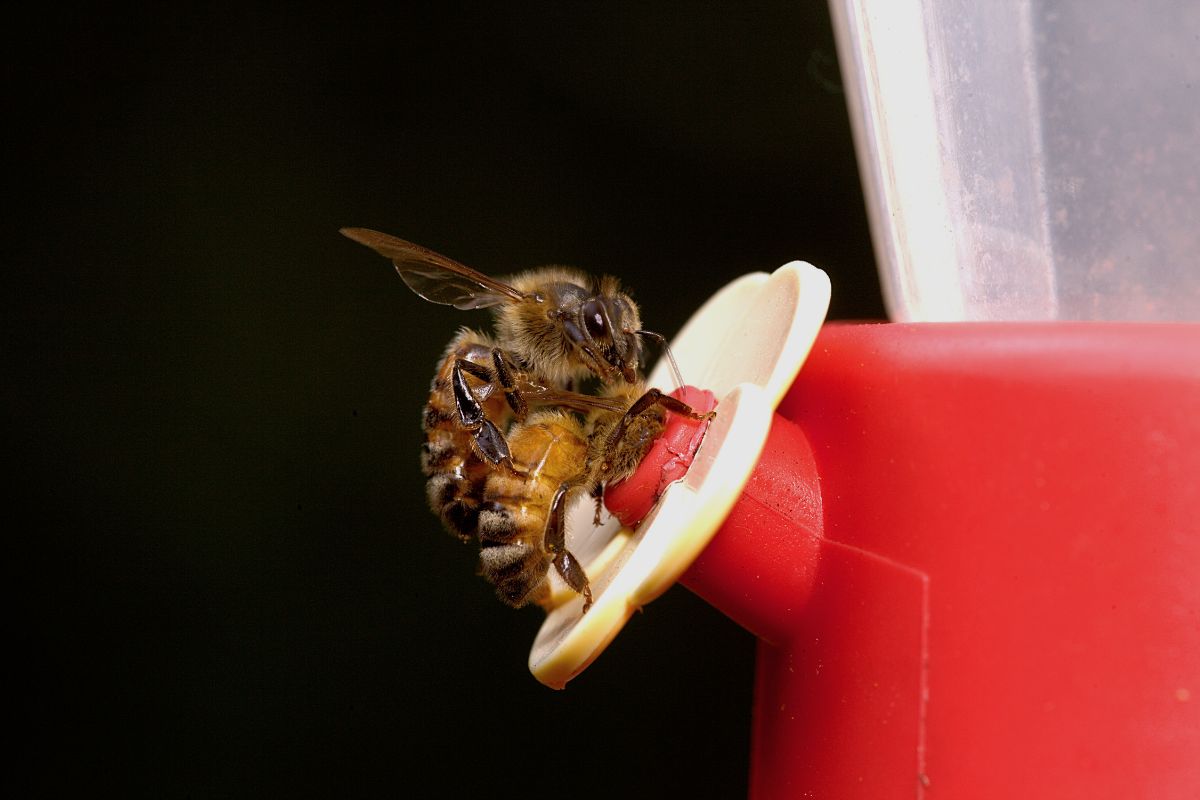Managing a hummingbird feeder can feel like hosting an exclusive party where uninvited guests keep showing up. While bees play a crucial role in our ecosystem, their presence at hummingbird feeders can create quite a buzzing problem.
As someone who’s spent years observing and maintaining hummingbird feeders, I understand the delicate balance between attracting these magnificent birds while keeping persistent bees at bay.
Have you ever wondered why bees seem particularly drawn to your hummingbird feeders, or what makes some feeders more attractive to them than others?
The answer lies in understanding both the behaviour of bees and the specific needs of hummingbirds. This knowledge forms the foundation of effective deterrent strategies that work without harming either species.
Key Takeaways
To keep bees away from hummingbird feeders, use saucer-style feeders with built-in nectar guards, avoid yellow colours, and maintain proper cleaning routines.
These methods ensure hummingbirds can feed peacefully while bees remain unharmed.
- Choose the right feeder design: Saucer-style feeders naturally prevent bee access while allowing hummingbirds to feed
- Implement physical barriers: Install nectar guards and bee guards to restrict bee access
- Create an environment that discourages bees: Use red feeders, proper placement, and alternative food sources
- Maintain proper feeder hygiene: Regular cleaning and leak prevention are essential.
Related Posts:
Best Hummingbird Feeders.
Hummingbird Feeders Comprehensive Guide.
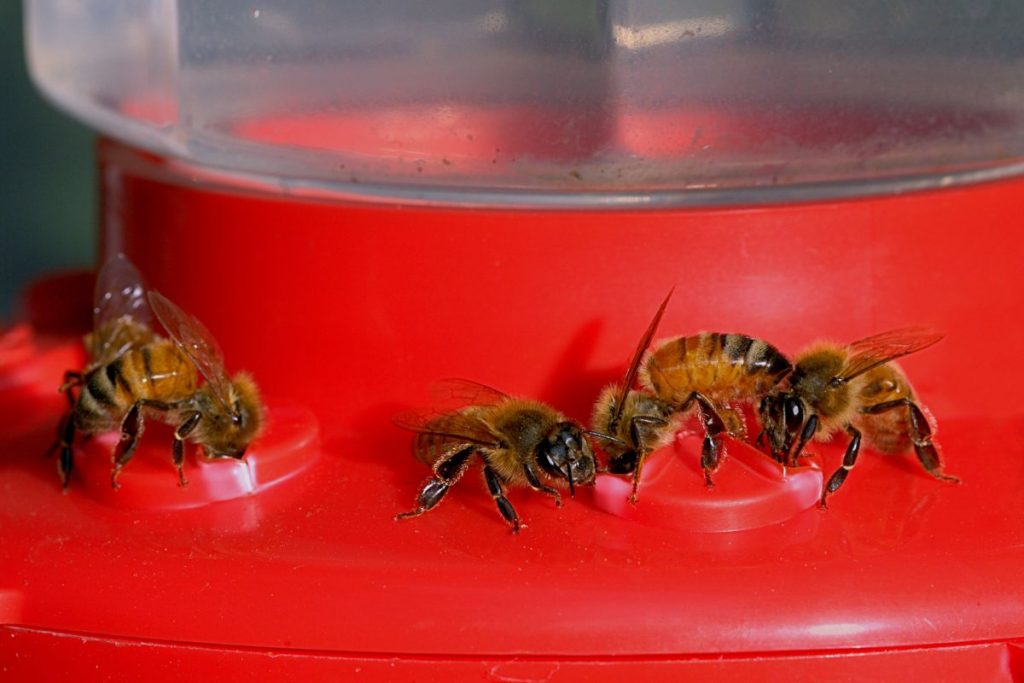
What Are the Most Effective Ways to Keep Bees Away from Hummingbird Feeders?
The most effective approach to keeping bees away from hummingbird feeders combines proper feeder selection with strategic placement and maintenance.
By using red-coloured, saucer-style feeders with built-in nectar guards, placing them in shaded areas, and maintaining a regular cleaning schedule, you can significantly reduce bee activity while keeping hummingbirds happy.
1. Use Saucer-Style Feeders
Saucer-style feeders represent one of the most effective solutions for deterring bees while ensuring hummingbirds can feed comfortably. These feeders feature a unique design where the nectar sits below the feeding ports, making it practically impossible for bees to reach the sweet liquid.
The feeding ports are specifically designed to accommodate hummingbirds’ long tongues while keeping shorter-tongued insects at bay.
Benefits of saucer-style feeders:
- Natural deterrent without additional modifications
- Reduced nectar waste through leakage
- Easier to clean and maintain
- More stable in windy conditions.
2. Install Nectar Guards
Nectar guards serve as an additional layer of protection against unwanted visitors. These small plastic tips cover the feeding ports and work like one-way valves, allowing hummingbirds to access the nectar while blocking bees and wasps.
How to properly install nectar guards:
- Ensure guards fit snugly over feeding ports
- Check regularly for damage or wear
- Clean guards during routine feeder maintenance
- Replace guards if they become loose or damaged.
3. Avoid Yellow Feeders
The colour of your feeder plays a crucial role in attracting or deterring bees. Bees have a natural attraction to yellow and other bright colours, while hummingbirds are primarily attracted to red. By choosing red feeders, you can naturally discourage bees while still attracting your target visitors.
Colour selection tips:
- Choose predominantly red feeders
- Avoid yellow ports or flower decorations
- Consider painting yellow parts red
- Remove yellow insect guards if present.
4. Strategic Feeder Placement
The location of your feeder can significantly impact bee activity. Moving your feeder periodically by a few feet can help reduce bee visits while maintaining hummingbird traffic. Hummingbirds are intelligent and adaptable, quickly finding relocated feeders, while bees may lose track of the food source.
Optimal placement strategies:
- Relocate feeders every few days if bee activity increases
- Keep feeders away from known bee nesting areas
- Maintain distance from flowering plants that attract bees
- Consider height variations in placement.
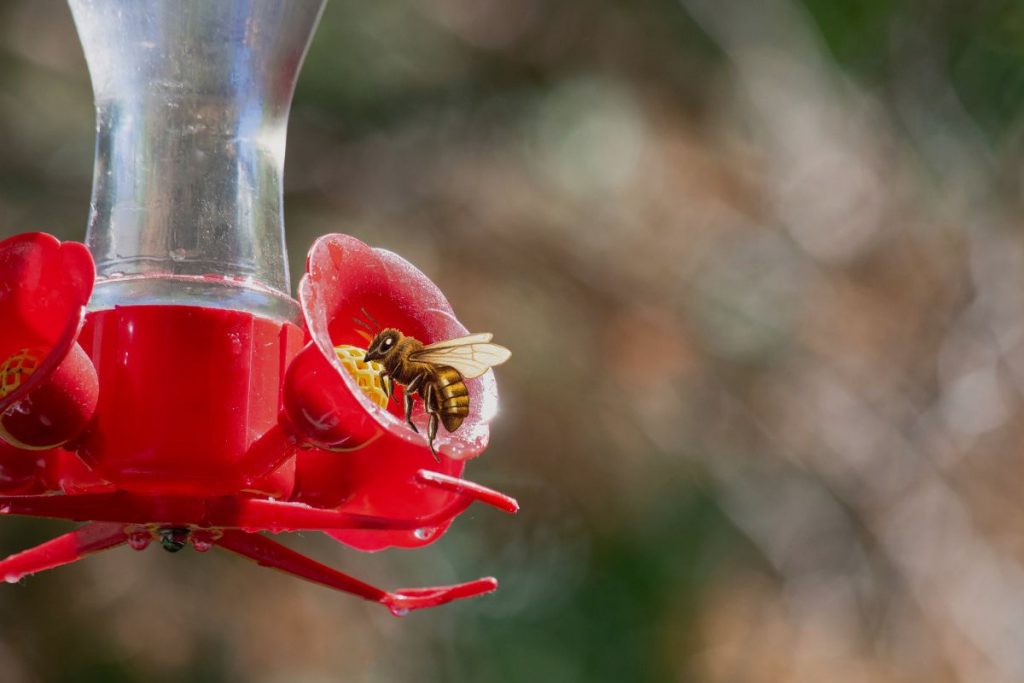
5. Adjust Nectar Concentration
The sweetness of your nectar solution can attract or deter bees. Using a more diluted mixture of 5:1 (water to sugar) instead of the standard 4:1 ratio can make the nectar less attractive to bees while still providing adequate nutrition for hummingbirds.
Proper nectar preparation:
- Use pure cane sugar only
- Avoid honey or artificial sweeteners
- Mix thoroughly until sugar dissolves completely
- Replace nectar every 3-4 days.
6. Maintain Proper Cleanliness
Regular cleaning is essential for preventing bee activity at your feeders. Sticky residue and spills create powerful attractants for bees and other insects. Establishing a proper cleaning routine helps maintain a bee-free feeding station.
Cleaning protocol:
- Clean feeders every 3-4 days
- Use hot water and mild soap
- Rinse thoroughly to remove all soap residue
- Dry completely before refilling.
7. Utilize Shade Placement
Bees prefer to forage in sunny areas, while hummingbirds will happily visit feeders in shade. Taking advantage of this preference can help reduce bee activity at your feeders.
Shade placement considerations:
- Choose naturally shaded areas
- Use artificial shade if necessary
- Monitor sun patterns throughout the day
- Adjust placement seasonally.
8. Add Bee Guards
Bee guards provide an additional physical barrier against unwanted visitors. These small grates prevent bees from accessing the nectar while allowing hummingbirds to feed normally through their long beaks.
Installing bee guards:
- Choose guards compatible with your feeder
- Ensure proper fit and seal
- Clean guards regularly
- Replace damaged guards promptly.
9. Create Bee-Specific Feeding Stations
Setting up alternative feeding stations for bees can help redirect them away from hummingbird feeders. This approach acknowledges the importance of bees while protecting your hummingbird feeding area.
Creating bee feeding stations:
- Use stronger sugar solution (2:1 ratio)
- Place in sunny locations
- Position away from hummingbird feeders
- Include yellow decorative elements.
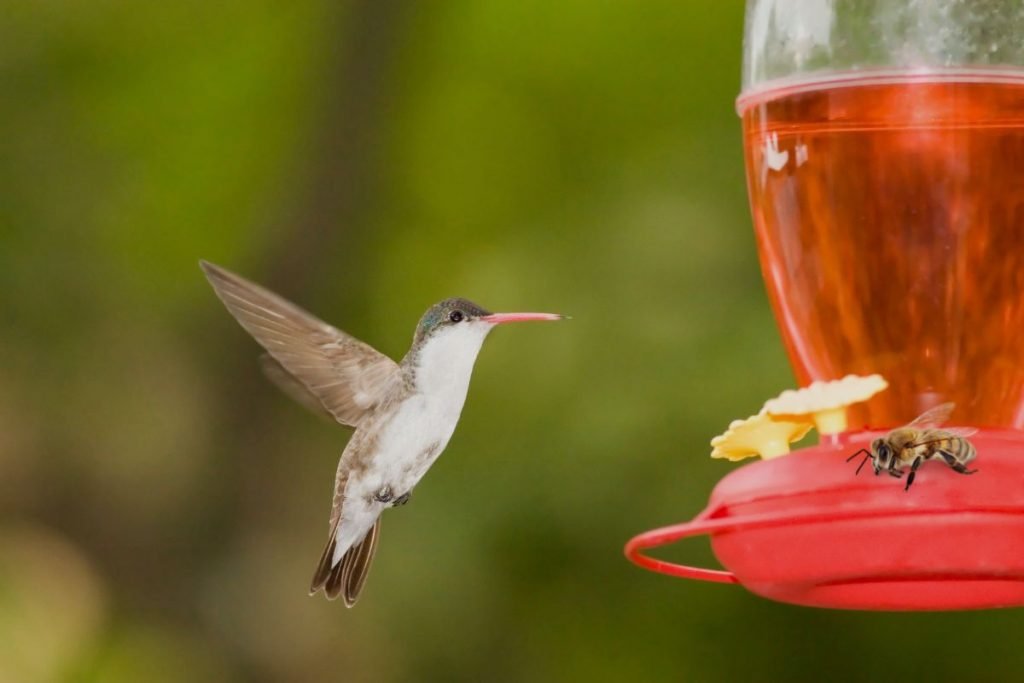
10. Address Leakage Issues
Leaky feeders create an open invitation for bees. Ensuring your feeders are properly sealed and maintained helps prevent the sticky situations that attract bees.
Leak prevention:
- Check seals and connections regularly
- Tighten all components properly
- Replace worn parts promptly
- Monitor for drips and spills.
11. Install Fake Wasp Nests
Wasps and bees are territorial insects that avoid areas where they perceive competition or danger. Installing fake wasp nests near your hummingbird feeders can create a natural deterrent.
Implementing fake nests:
- Place within visible range of feeders
- Use multiple nests for larger areas
- Replace when weathered
- Position at various heights.
12. Create Bee-Friendly Gardens
Establishing dedicated areas for bees away from your hummingbird feeders provides them with natural alternatives. This approach supports both species while reducing competition at feeders.
Garden planning tips:
- Plant bee-attractive flowers
- Create distinct feeding zones
- Include variety of bloom times
- Maintain proper spacing.
13. Use Ant Moats
While primarily designed for ants, ant moats can also help deter bees and wasps. These water-filled barriers create an additional obstacle for insects trying to reach the feeder.
Moat maintenance:
- Keep water levels consistent
- Clean regularly
- Check for proper installation
- Replace if damaged.
14. Avoid Harmful Deterrents
Some commonly suggested deterrents can actually harm hummingbirds. Avoid using oils, petroleum jelly, or sticky substances that could damage birds’ feathers.
Safe practices:
- Use only mechanical barriers
- Avoid chemical deterrents
- Skip sticky substances
- Focus on prevention.
15. Manage Aggressive Wasps
While similar to bees, wasps can be more aggressive and persistent. Using specific strategies to manage wasp populations can help create a safer feeding environment.
Wasp management:
- Use non-toxic wasp traps
- Position traps away from feeders
- Monitor trap effectiveness
- Empty and clean regularly.
Final Thoughts
Creating a peaceful feeding environment for hummingbirds while respecting the role of bees requires a thoughtful, balanced approach. By implementing these 15 strategies, you can significantly reduce bee activity at your hummingbird feeders while ensuring both species thrive in their preferred environments.
Remember that consistency in maintaining these methods is key to their effectiveness, and combining multiple approaches often yields the best results. As you apply these techniques, observe what works best in your specific situation and adjust accordingly.
The goal isn’t to eliminate bees entirely but to create separate, sustainable feeding opportunities for both our hovering jewels and our precious pollinators.
Frequently Asked Questions About Bee-Proof Hummingbird Feeders
Question: What Makes A Hummingbird Feeder Bee-Proof?
Answer: A bee-proof hummingbird feeder combines specific design features that prevent bees from accessing the nectar while allowing hummingbirds to feed.
The key elements include narrow feeding ports that only accommodate hummingbird bills, protective mesh guards over the ports, a saucer-style design that keeps nectar below reach, and predominantly red colouring that attracts hummingbirds but not bees.
Additionally, these feeders maintain a leak-proof construction to prevent nectar spills that might attract bees.
Question: How Often Should I Clean My Bee-Proof Hummingbird Feeder?
Answer: You should clean your bee-proof hummingbird feeder at least once a week in cool weather and every 2-3 days in hot weather. Regular cleaning prevents mold growth, maintains the effectiveness of bee-proof features, and ensures the nectar stays fresh.
Use a mild soap solution and warm water, making sure to thoroughly clean all ports and guards. Rinse well to remove any soap residue that might harm the hummingbirds.
Question: What’s the Best Recipe for Hummingbird Nectar That Won’t Attract Bees?
Answer: The ideal nectar recipe that minimizes bee attraction while still appealing to hummingbirds is a 1:5 ratio of white sugar to water (one part sugar to five parts water). Avoid using honey, artificial sweeteners, or red dye.
Mix until the sugar completely dissolves, and let it cool to room temperature before filling the feeder. This concentration is less attractive to bees while still providing proper nutrition for hummingbirds.
Question: Where Should I Place My Bee-Proof Feeder to Maximize Its Effectiveness?
Answer: Place your bee-proof feeder in a shaded area at least 10-15 feet away from known bee-attractive plants or hives.
Hang it about 5-6 feet off the ground, ideally near natural perches for hummingbirds but away from areas where bees frequently gather.
Consider placing it near red or pink flowers that naturally attract hummingbirds but aren’t as appealing to bees.
Question: Why Are Bees Still Coming to My Bee-Proof Feeder?
Answer: If bees are still attracted to your bee-proof feeder, check for these common issues: nectar leaks or spills around the ports, damaged or worn bee guards, incorrect nectar concentration (too sweet), or yellow decorative elements on the feeder that might attract bees.
Also, during periods of natural nectar scarcity, bees may be more persistent in their attempts to access any available food source.
Try temporarily relocating the feeder or adjusting the nectar recipe to reduce its attractiveness to bees.
Image Gallery – How To Keep Bees Off Hummingbird Feeder



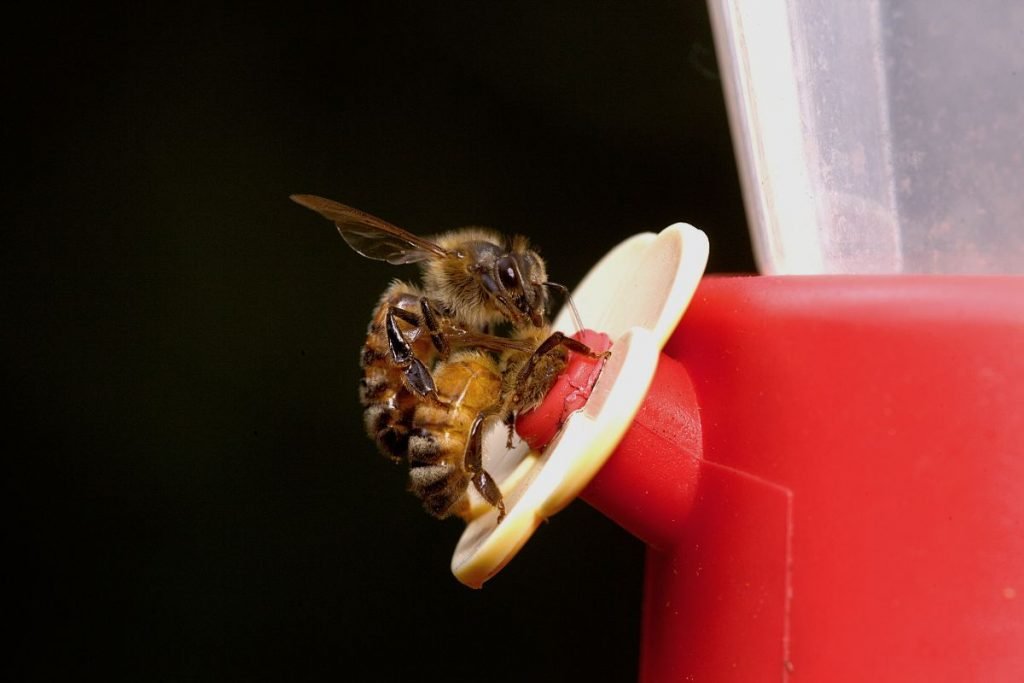
Citation:
